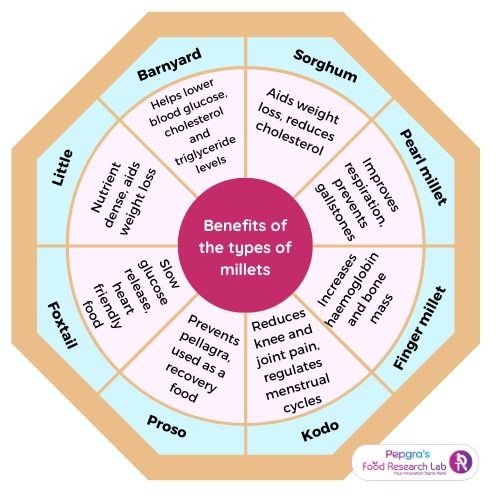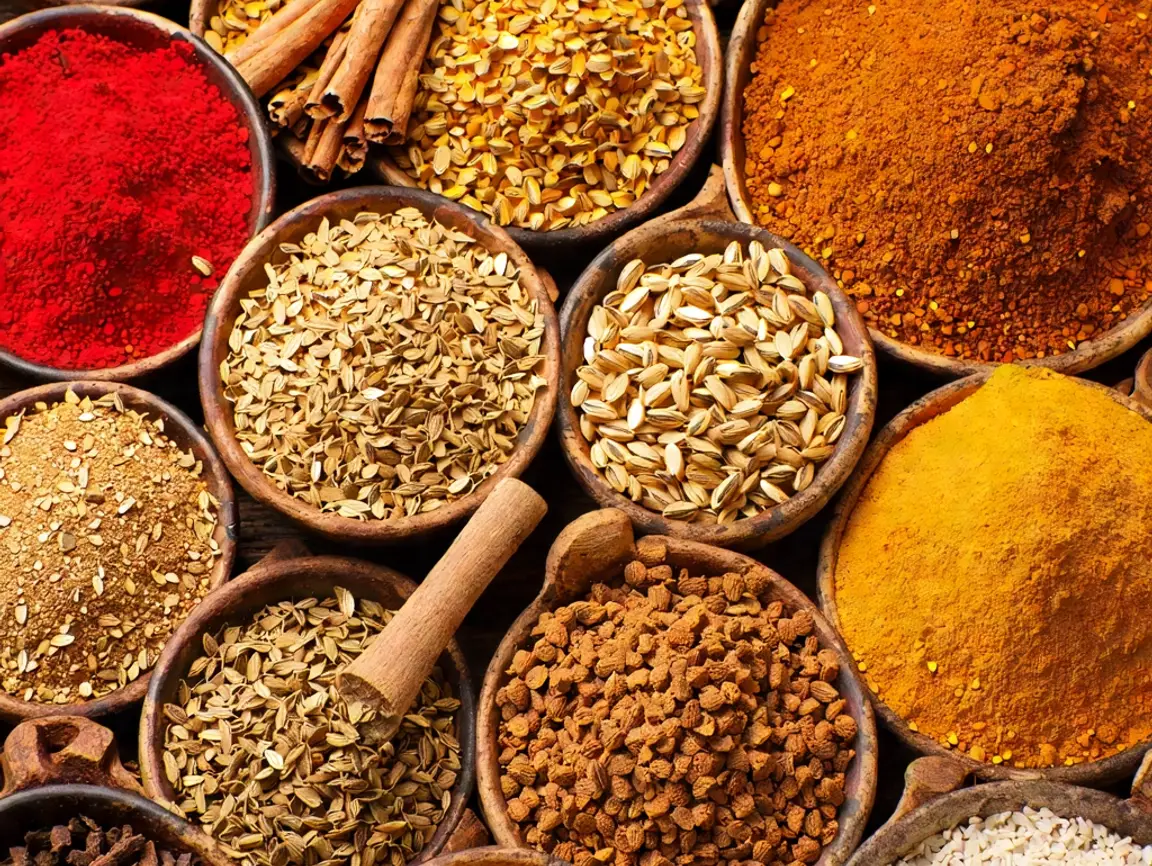
Turmeric : The Golden Spice of India
Turmeric, with its brilliant golden color and captivating, earthy aroma, boasts a history as opulent as its flavor profile. This
Free Shipping on all orders…
Free Shipping on all orders…
8421-69-70-71

Millets are often referred to as “nutri-cereals” due to their exceptional nutritional profile. They are rich in essential vitamins, minerals, antioxidants, and dietary fiber, making them a superior alternative to refined grains like rice and wheat. Below, we explore the health benefits of millets in detail, supported by case studies that highlight their transformative impact on human health.
Millets are packed with essential nutrients, including:
Protein: Millets like finger millet (ragi) and pearl millet (bajra) are excellent sources of plant-based protein.
Fiber: High dietary fiber content aids digestion and prevents constipation.
Minerals: Millets are rich in iron, calcium, magnesium, and zinc.
Vitamins: They contain B-complex vitamins, including niacin, thiamine, and riboflavin.
Antioxidants: Millets like foxtail millet are rich in antioxidants, which combat oxidative stress and inflammation.
Case Study: Finger Millet in Combating Malnutrition in India
In Karnataka, India, finger millet (ragi) has been a staple in addressing malnutrition, especially among children and pregnant women. A study conducted by the Indian Institute of Science (IISc) found that incorporating ragi into the diets of anemic women significantly improved their hemoglobin levels within three months. The high iron and calcium content in ragi also helped reduce the prevalence of osteoporosis in elderly populations. Schools in Karnataka have introduced ragi-based mid-day meals, resulting in improved growth and cognitive development among children.
Millets are naturally gluten-free, making them a safe and nutritious option for individuals with celiac disease or gluten intolerance.
Case Study: Millets in Gluten-Free Diets in the U.S.
In the United States, millets have gained popularity as a gluten-free alternative to wheat. A study published in the *Journal of Nutrition and Dietetics* found that individuals with celiac disease who replaced wheat-based products with millet-based foods experienced significant improvements in digestive health and nutrient absorption. Companies like Bob’s Red Mill have introduced millet flour and millet-based snacks, catering to the growing demand for gluten-free products.
Millets have a low glycemic index (GI), which means they release glucose slowly into the bloodstream, preventing sudden spikes in blood sugar levels. This makes them an excellent choice for diabetics.
Case Study: Foxtail Millet in Diabetes Management in China
In China, foxtail millet has been traditionally used to manage diabetes. A clinical trial conducted by the Chinese Academy of Agricultural Sciences found that diabetic patients who consumed foxtail millet as a staple food experienced a 15-20% reduction in fasting blood glucose levels over six months. The study also noted improvements in insulin sensitivity and lipid profiles, highlighting the potential of millets in diabetes management.
Millets are rich in dietary fiber, magnesium, and potassium, which contribute to heart health by reducing cholesterol levels and regulating blood pressure.
Case Study: Pearl Millet in Reducing Cholesterol in Nigeria
In Nigeria, pearl millet (bajra) has been used to address cardiovascular diseases. A study by the University of Ibadan found that individuals who consumed pearl millet regularly had lower levels of LDL (bad cholesterol) and higher levels of HDL (good cholesterol). The magnesium content in pearl millet also helped regulate blood pressure, reducing the risk of hypertension.
The high fiber content in millets promotes satiety, reducing overall calorie intake and aiding in weight management.
Case Study: Millets in Obesity Prevention in Japan
In Japan, millets like barnyard millet have been incorporated into weight-loss diets. A study by the National Institute of Nutrition in Japan found that individuals who consumed millet-based meals felt fuller for longer and consumed fewer calories throughout the day. Over six months, participants experienced an average weight loss of 5-7%, along with improvements in metabolic health.
Millets like finger millet are exceptionally rich in calcium and magnesium, which are essential for maintaining strong bones and preventing osteoporosis.
Case Study: Finger Millet in Bone Health in Ethiopia
In Ethiopia, finger millet has been used to address calcium deficiency, particularly among women and children. A study by the Ethiopian Public Health Institute found that women who consumed finger millet regularly had a 30% lower incidence of osteoporosis compared to those who did not. The study also noted improvements in bone density among children, highlighting the role of millets in promoting bone health.
The high dietary fiber content in millets aids digestion, prevents constipation, and promotes a healthy gut microbiome.
Case Study: Millets in Digestive Health in Australia
In Australia, millets have been introduced as part of a gut health initiative. A study by the University of Melbourne found that individuals who consumed millet-based diets experienced improved gut health, with increased levels of beneficial gut bacteria. Participants also reported reduced symptoms of irritable bowel syndrome (IBS) and better overall digestive function.
Millets are rich in antioxidants like polyphenols, which help combat oxidative stress and reduce the risk of chronic diseases like cancer and cardiovascular diseases.
Case Study: Antioxidant Benefits of Foxtail Millet in South Korea
In South Korea, foxtail millet has been studied for its antioxidant properties. Research by the Korea Food Research Institute found that regular consumption of foxtail millet reduced oxidative stress markers in the blood by 25%. The study also noted a reduction in inflammation, highlighting the potential of millets in preventing chronic diseases.
Millets are not just grains; they are a powerhouse of nutrition with proven health benefits. From combating malnutrition and managing diabetes to promoting heart and bone health, millets have demonstrated their transformative potential across the globe. Supported by real-world case studies, millets stand out as a sustainable and nutritious solution to some of the most pressing health challenges of our time. As we embrace the “Year of Millets,” let us recognize and harness the power of these ancient grains for a healthier, more resilient future.
Millets are not just grains; they are a powerhouse of nutrition with proven health benefits. From combating malnutrition and managing diabetes to promoting heart and bone health, millets have demonstrated their transformative potential across the globe. Supported by real-world case studies, millets stand out as a sustainable and nutritious solution to some of the most pressing health challenges of our time. As we embrace the “Year of Millets,” let us recognize and harness the power of these ancient grains for a healthier, more resilient future.

Turmeric, with its brilliant golden color and captivating, earthy aroma, boasts a history as opulent as its flavor profile. This

Indian cuisine is renowned globally for its intricate and multi-layered flavors, achieved through a masterful blend of spices known as